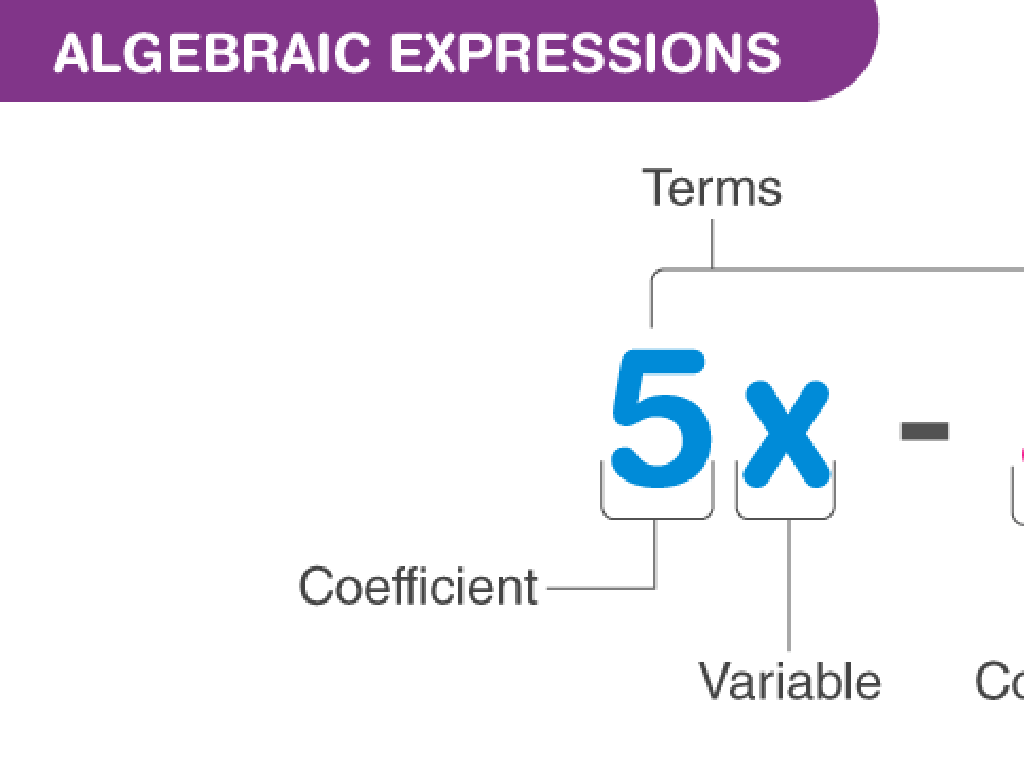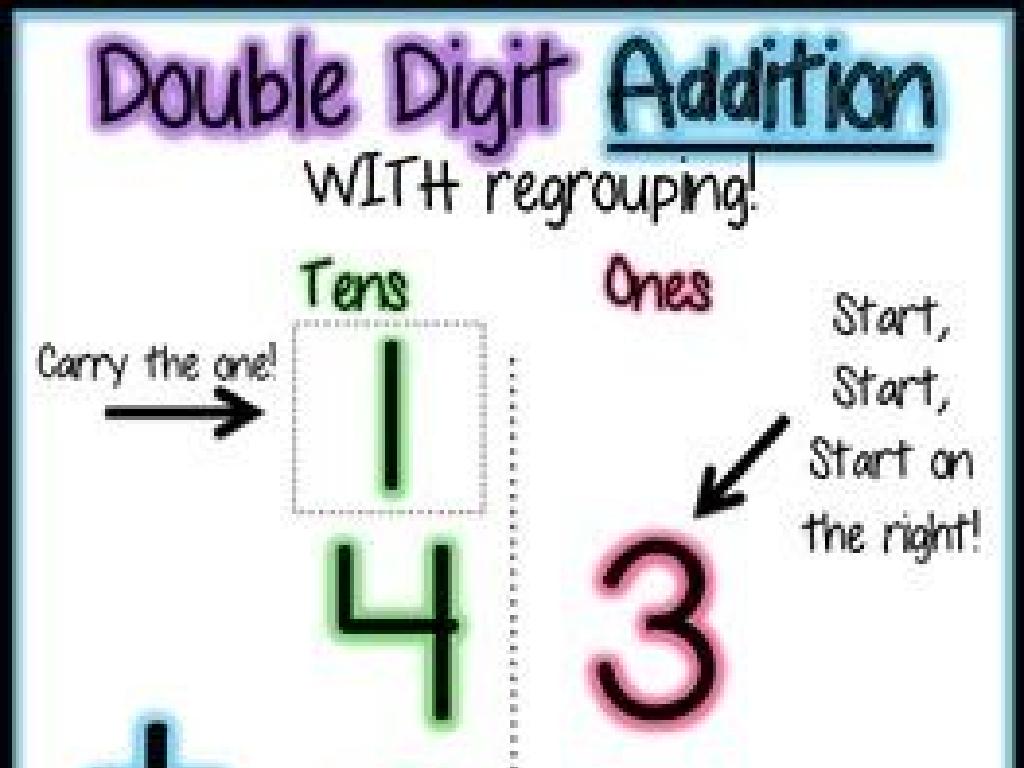Add Three Numbers
Subject: Math
Grade: First grade
Topic: Addition Up To 20
Please LOG IN to download the presentation. Access is available to registered users only.
View More Content
Welcome to Addition!
– Greetings First Graders!
– Today’s lesson: adding three numbers
– We’ll add numbers like 2 + 3 + 4
– Adding makes counting quicker
– Instead of counting each item, we add for speed
– Let’s practice with fun examples
– Example: 3 apples + 2 oranges + 1 banana
|
This slide is designed to introduce first graders to the concept of addition as a tool for counting more efficiently. Start by greeting the students warmly to create an inviting learning environment. Explain that today’s focus will be on learning how to add three numbers together, which is a skill that will help them count things much faster in everyday life. Use tangible examples like fruits, toys, or other familiar items to demonstrate how addition works and to keep the lesson engaging. Encourage participation by asking students to suggest items to add together. The goal is to make the concept of addition relatable and fun, setting a positive tone for the rest of the lesson.
Understanding Addition
– Addition combines numbers
– It’s finding the total, like 2 apples + 3 apples = 5 apples.
– Like joining groups of items
– Imagine 2 baskets of oranges and 3 baskets of apples becoming one big fruit basket.
– The plus sign (+) is key
– We use ‘+’ to add, like 4 + 4 = 8.
– Practice with examples
– Try adding toys: 3 teddy bears + 2 dolls.
|
This slide introduces the concept of addition to first graders by explaining it as a process of combining numbers or groups of items. Use relatable examples like combining fruits or toys to make the concept more tangible for the students. Emphasize the use of the plus sign (+) as the symbol for addition, and encourage students to practice with real-life examples. You can use physical objects like counters or drawings to help them visualize the process. The goal is to make them comfortable with the idea of addition as a way of finding out how many items they have in total when groups are combined.
Adding Numbers Together
– Start with adding two numbers
– Example with apples
– If you have 2 apples and 3 apples, how many in total?
– Adding gives us a total
– 2 apples + 3 apples equals 5 apples
– Practice with different items
– Try adding balls, pencils, or toys
|
This slide introduces the concept of addition by starting with something simple: adding two numbers. Use the example of apples to make it relatable and easy to visualize for first graders. Explain that when we add, we are finding out how many items we have in total. Encourage the students to practice with different items to reinforce the concept. Make sure to use items that are familiar to them and encourage them to use their fingers or physical objects to count if necessary. This will set the foundation for moving on to adding three numbers.
Adding Three Numbers Together
– Learn to add three numbers
– Numbers can be added in any order
– This is called the commutative property of addition
– Example: 1 + 2 + 3
– Adding 1, then 2, then 3 equals 6
– Same as: 3 + 1 + 2
– Reordering them, we still get 6
|
This slide introduces the concept of adding three numbers, emphasizing the commutative property of addition, which states that numbers can be added in any order and the sum will remain the same. Use simple examples that add up to 6 or less to ensure the concept is within the grasp of first graders. Encourage students to practice with different combinations of numbers up to 20, using objects like counters or drawings to visualize the concept. Reinforce that no matter the order, the total sum does not change, which is a fundamental principle of addition.
Let’s Practice Together: Adding Three Numbers
– Start with 4 + 1 + 3
– First add 4 and 1 to get 5
– Combining the first two numbers makes it easier
– Next add 5 to the last number 3
– Adding 5 and 3 completes our sum
– The sum of 4 + 1 + 3 is 8
– Practice makes perfect! Try with different numbers
|
This slide is a class activity designed to help first graders practice the concept of adding three numbers together. The example provided uses small numbers to ensure the concept is easily understood. The process is broken down into steps: first adding the first two numbers, then adding the result to the third number. This methodical approach helps students understand the process of addition in manageable parts. Encourage students to use their fingers or counters if they need a tactile method to find the sum. After explaining the example, give students a chance to try similar problems with different numbers to reinforce the concept.
Your Turn to Try: Adding Three Numbers!
– Now it’s your turn to practice
– Add numbers in any order
– Try adding: 2 + 5 + 1
– What’s 2 plus 5 plus 1?
– More sums: 6 + 2 + 3, 4 + 4 + 2
– Find the totals for each sum
|
This slide is an interactive activity for students to practice adding three numbers together. Remind them that one of the great things about addition is that the order of numbers doesn’t change the result. Encourage them to start with the easiest or most familiar pairs to add first, which might make adding the third number simpler. For example, they might notice that 2 + 1 is easy because it makes 3, and then they just need to add 5. Provide guidance on how to approach addition problems and ensure they understand that they can use their fingers, objects, or mental math to find the answers. Prepare to walk around the classroom to assist students who might need help and to check their work. Have a few students share their answers and how they got them to reinforce the concept.
Addition Game Time!
– Let’s play an addition game
– I’ll give you three numbers
– You tell me the total sum
– For example, 2 + 3 + 4 equals?
– Ready to have fun adding?
|
This slide is designed to engage first-grade students in a fun and interactive game that helps them practice the skill of adding three numbers together, with sums up to 20. The teacher will provide three numbers to the students, and they will work out the total sum. It’s a great way to reinforce their addition skills in a playful and enjoyable manner. For the activity, consider using physical objects like counters, blocks, or even fingers to help them visualize the addition process. Encourage students to participate actively and praise their efforts to build confidence. Possible variations of the game could include using dice to generate random numbers, pairing students to solve together, or creating a point system for correct answers to add a competitive element.
Class Activity: Addition Relay Race
– We will form groups for a relay race
– Each group receives number cards
– Take turns to add numbers to your total
– Run up and add a card to your group’s total on the board
– First group to reach 20 points wins!
|
This activity is designed to make learning addition up to 20 fun and interactive. Divide the class into small groups and give each group a set of number cards. Students will take turns running to the front of the class to add a number card to their group’s running total, which they will calculate and display on the board. The first group to accurately add their numbers to reach exactly 20 wins the race. This exercise encourages teamwork, quick thinking, and practical application of addition skills. Possible variations include using different target numbers, timing each group for speed, or having students draw their own number cards from a central pile to add an element of chance to the game.
Super Adders: Adding Three Numbers
– Excellent work today!
– Practice is key to success
– Try adding with toys or snacks
– Use items like blocks or candies to practice
– See you next class, superstars!
|
This slide is meant to congratulate the students on their hard work during the lesson on adding three numbers. Emphasize the importance of practice in mastering addition skills. Encourage them to use everyday items like toys or snacks to continue practicing at home, making the activity both fun and educational. This will help reinforce their learning in a practical context. End the class on a positive note, calling them ‘super adders’ to boost their confidence and excitement for the next lesson.






